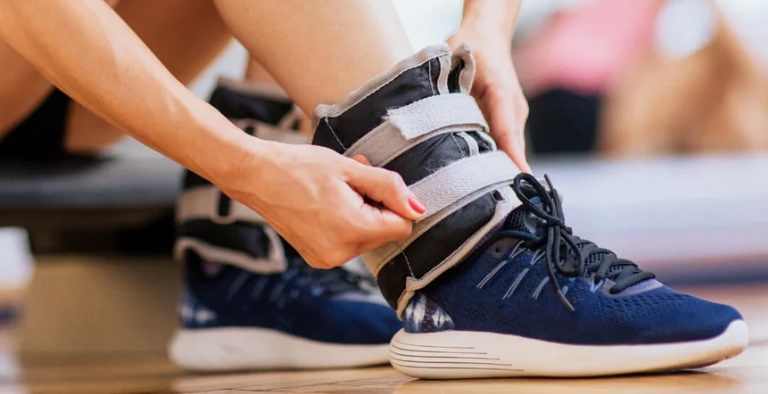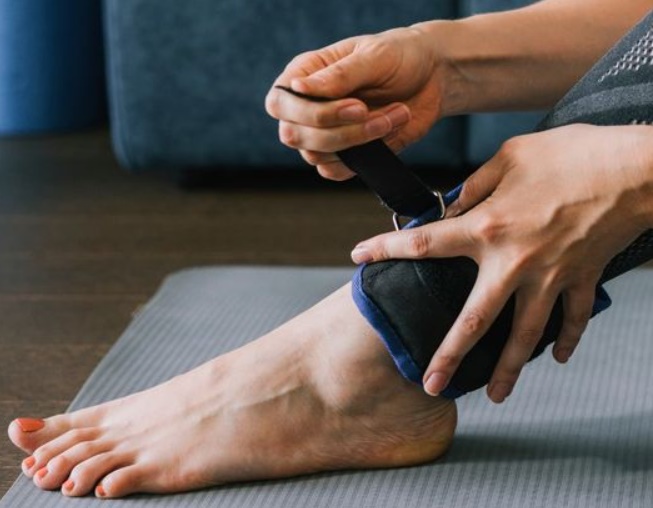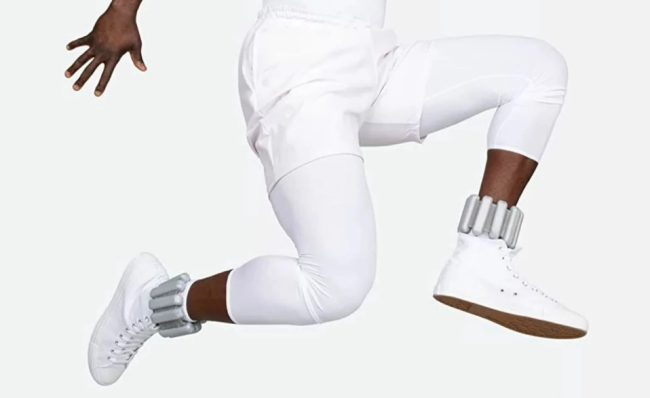The legs are extremely crucial in dancing, as they are responsible for balance and all the motions you are trying to pull off.
However, is it truly effective to use ankle weights for dancers who need to improve their strength, stamina, and overall movement control?
Let’s see the matter from multiple aspects so you can have a clear opinion on this trendy equipment!
Table of Contents
What Are Ankle Weights?
Ankle weights are additional devices added to one’s daily and promise to make your fitness better through regular practice.
Before getting to work, you will slip them on and exert more than you usually do in hopes of building your endurance and improving your stamina.
Ankle weights are often filled with sand, iron powder, steel shot, or water – all of them have a high density.
While sand is generally the most commonly used material here for its great mold on our body, it leaks easily and thus loses its quality over time.
The steel filling is a good alternative if you are not a fan of the leakage.
Are ankle weights really good for dancers?
As with any other type of weight, ankle weights are mainly used for strengthening muscles and enhancing cardiovascular health for dancers. They need extreme control and precision over their legs for demanding movements such as jumping, leaping, kicking, and many more.
When used properly, ankle weights help dancers move more freely. Traditional tools like dumbbells tend to prevent you from rotating movements and give you no chance to work your hips.
If you haven’t danced for a long time and want to find your way back to dancing, a sufficient weight on your ankles will be a good push for the inactive muscles in your legs and prepare you for upcoming practices.
Furthermore, ankle weights act as a form of exercise for toned legs and abdomen too. Although most dancers are people with enough burned calories every day, no one will say no to an opportunity for body enhancement.
Where To Wear Ankle Weights?
Most people think slipping the weights around their ankles is everything they need to do, yet careless preparation might lead to injuries.
- First of all, check that the ankle weights have intact seams. If they are adjustable, the added plates should be a full closure.
- Wrap the weights around your lower legs and make sure the fit is snug but not overly tight because it disrupts air circulation. Beginners sometimes assume they need to tie the weights around their ankles, which isn’t the case.
- If you feel like the weights cause your skin some discomfort, you can put them over your socks or pants.
- Use fasteners or hooks & loops to secure the closure as you like it.
Some manufacturers design their ankle weights to be changeable so the customers can use them on the wrists or arms.
Read more: Ultimate Guide About Leg Warmers For Dancers
How To Use Ankle Weights?
Before you add ankle weights to your exercises, be sure you are not having any difficulty in doing your current routines.
In that case, you will be able to maintain a precise and proper posture throughout the practice, which saves you from getting unwanted injuries or not making the most out of your equipment.
Another thing to be done is to consult a doctor in charge of your condition. Your health practitioner is the one who knows your health the best, so they can give you advice about how efficient or dangerous ankle weights might be for you.
Choose the suitable weights
There must be a balance between your body weight and the exercise you want to do.
For dancers, the weights need to be heavy enough to make their muscles work harder and not limit their movements at the same time.
To achieve both goals, the range of your ankle weights should be 1 – 5 lbs on each leg, depending on how trained you are. Adding unnecessary weight will only alter your posture and stress your pressure points, leading to muscle pain.
Take your time
Always take short sessions with your ankle weights, no matter how eager you are to level up your strength.
We don’t recommend keeping the weights on your legs 24/7, for it only strains your muscles constantly and leaves your skin so little room to breathe.
Barre exercises and pilates for dancers are considered low-impact practices with concentrated and controlled motions. Hence, wearing your ankle weights frequently at one-day intervals might give you amazing improvement.
It’s always a safe and wise idea to start with small weights and increase the mass gradually once you have confirmed that you feel comfortable with the equipment.
3 Best Ankle Weights for Dancers
Ankle weights are a rather popular merchandise nowadays, which makes the task of choosing a suitable product for you and your schedule.
We have paid attention to these three pairs of ankle weights for their excellent design, impressive materials, and various weight ranges for different types of dancers looking to enhance themselves.
El Toro Ankle Weights
Regarding ankle weights, El Toro has a different idea. Instead of making the weights look like bangles and bunch around the ankles, they come up with a design that looks a bit more like a short leg sleeve and distributes the mass along the length of your calf.
With a closure made of loops and hooks, the fit is bound to be very secure without slips, unless you have got the wrong size. Even when you aim for a snug fit, you won’t feel any discomfort due to the innovative Dri-FIT fabrics wicking moisture and sweat.
Although the focus is still on your ankles, this thorough distribution of weight reduces the pressure your Achilles tendon has to endure, giving you constant comfort for hours of practice (yet we don’t recommend such long sessions while wearing ankle weights).
Nonetheless, this design and the mass coming with it are more suitable for rookies than experienced dancers. It weighs enough to not cause injuries, though only the user can decide whether it is sufficient for their training or not.
Pros:
- Waterproof and stretchy materials
- Ergonomic distribution for the weight
- Not bulky like other weights
Cons:
- 1 – 2 lbs per ankle won’t be enough for well-trained dancers
- The closure might be a bit troublesome
Bala Adjustable Ankle Weights
We immediately notice how quick these Bala bangles are at catching up with the trends because the premium silicone material is sleek in appearance and versatile in style.
The water resistance is another bonus since the weights won’t absorb moisture, consequently easy to clean.
They also come with a durable velcro closure that secures a fit around your ankles and never budges even when you are performing energetic moves. Aside from the basic fit, the ankle straps adjust to different body shapes.
As we have mentioned previously, steel filling has become a favorite of many dancers and athletes, for they won’t leak all over and give you a mess to tidy up.
However, despite the mass being changeable, the range is only 0.5 – 2 lbs for each. It means you might not feel anything if you have been training for a long time and your muscle strength is already decent.
You might have to withdraw extra from your budget to own these ankle weights for dance training, yet it pays off in terms of quality, fit, and style with the design and color options.
Pros:
- Silicone is grippy and water-resistant
- The strap and the weight are both adjustable
- Six options for colors
Cons:
- A little more expensive than average products
- Only suitable for beginners
Gaiam Ankle Weights
A lot of ankle weights look extremely intimidating at first sight with scratchy materials and bulky plates, though Gaiam certainly knows the right way to go when designing these neat and comfortable weights for ankles.
With Gaiam, the weights will never slide up and down your calves unpleasantly thanks to the loops and the hooks ensuring the fit. When they are in an accurate position, they can target the right muscle groups and improve the efficiency of your exercise.
The downside we find in Gaiam weights is they still stick to the traditional sand filling. Besides the possible leakage, the problem is you will rarely find any filled weights being truly beginner-friendly.
The range of 2.5 – 5 lbs per ankle is only suitable for veteran dancers looking for a challenge.
With the weight, comes the size. To distribute the mass evenly, the sizing has to be slightly bigger than lighter weights. Knowing this drawback, Gaiam uses neoprene to prevent chaffing and remain breathable during your intensive dance sessions.
Pros:
- Less sweating and chaffing with high-quality materials
- Adjustable fit with hooks and loops
- A very convenient and youthful design
Cons:
- Not compatible with beginners
- The sand filling might leak and make a mess
What Do Dancers Need To Consider When Choosing Ankle Weights?
Now that we have confirmed that ankle weights can contribute to our dance practices and have quickly gone over a few beneficial products, the next step is even more important.
If you know what your body needs and what brings out the best in you, your choice will be so much more accurate.
How heavy should it be?
We are talking about weights for exercise, of course, the mass will be a key factor. If they are too light, they won’t be adequate as a challenge to strengthen your body.
But if they are too heavy, they might make you tired faster and vulnerable to accidents. As a starter, we estimate an ankle weight should be heavy in the range of 1 – 5 lbs.
For rookie dancers or new weight users, the weight should be 1 – 3 lbs on each ankle, and balance it with your body weight.
They are the most ideal limit for high-intensity activities like dancing. They make you work harder and increase your stamina without straining your muscles too much and putting you at risk of injuries.
For veterans, overly humble weights might be insufficient in training their endurance, hence they can consider raising the weights to 4 – 5 lbs.
We don’t recommend anything too heavy since it can limit your agility when dancing and subject you to unwanted incidents.
How much do you weigh?
Researchers have proven that the weights for your ankles should be 1 – 3% of your body weight if you are new to this training method. They are enough to push your muscles into working harder without hurting you or disrupting your balance.
As you build enough strength and want to challenge yourself, the limit can be 4 – 5%, yet don’t forget that pushing the boundary further will be more loss than gain!
Loose-fitting or tight-fitting weight?
Aside from how heavy the weights should be, you will need to pay attention to your body’s reaction. If you feel uncomfortable with the weights rubbing against your skin, it means they are an ill fit for you, regardless of their mess.
We recommend a balance between looseness and tightness.
An overly loose fit will have the weight slipping off constantly and not putting the right pressure on your ankles.
Meanwhile, the weight will press on your skin harshly and cause damage on different levels if it is too tight.
How good is the material?
Ankle weights will be directly in contact with your body, so they will be involved in the heat and the moisture coming from you.
Therefore, they will need to be made of comfortable and breathable materials. You don’t want materials that suffocate and irritate your skin.
Furthermore, do you plan to use your ankle weights indoors or outdoors?
If you practice in a studio, all materials work for you. On the other hand, dance sessions out in nature will demand waterproof materials for easy cleaning.
Disadvantages Of Ankle Weights
Despite all the benefits you might gain from ankle weights, they still have downsides.
In young dancers, muscles, joints, ligaments, and tendons are still developing and maturing. Thus, ankle weights can be too much for them to handle as well as slow the growth rates. The damage they take at this age might be permanent.
Even if you are an adult, wearing ankle weights constantly might lead to stressing your joints and tearing your ligaments. In the long run, you might end up having severe injuries and balance issues.
What To Use Instead Of Ankle Weights?
It’s completely understandable if you don’t want to take the risk, especially when there are alternative exercises for you to increase your endurance and stamina safely.
In ballet classes, barre exercises such as repeated grand battements and fondus will help your legs get stronger without using weights.
You can also take additional pilates lessons to strengthen your legs and your core at the same time.
Heel Walk
Instead of normal walking, use your heels to land on the ground and stride confidently for 60 seconds. Once done, you can take a short break and repeat it several times.
There is nothing tricky about this exercise, you only need to make sure your toes don’t touch the ground while you are walking.
Single Foot Press
Get into a squat position and lift your heel off the floor, pressing yourself toward the ground.
When you feel like your ankle is steady with your foot still raised, engage your core and do squatting motions. You can do 15 – 20 reps for each side and repeat the exercise twice or thrice.
Calf Raise
You will need a slightly elevated foothold, on which you stand with the ball of your feet and keep your heels hanging off the edge.
Put more strength in your toe and raise your heels before letting it fall to the original position and repeating the motion. You can do about 30 reps at once and do the exercise several times.
Final Words
Using ankle weights for dancers can come with great benefits if they have built a good base of strength and skill because they will be able to challenge themselves without getting injured.
For people who still need more time to deliberate, a few simple exercises might be very helpful in strengthening your legs and not hurting yourself!





